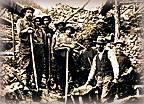

Fundstellen aus der "Encarta 98"
Alaska can be divided into three major climate zones: a region of maritime influences (a marine west coast climate), a region of continental (or subarctic) climate, and a region of tundra (or arctic) climate.
The region of maritime climate comprises the Panhandle, the coast of the Gulf of Alaska, and the Aleutian Islands. Grey skies, successive wet days, dampness, fogginess, and occasional gales are characteristic here, and the abundant snowfall provides the source for many glaciers. Summers are cool, and winters relatively mild.
The region of continental climate comprises Interior Alaska, the area north of the Alaska Range and south of the Brooks Range, where there are mild, brief summers and harsh winters.
The average January temperature is -22.8° C (-9° F), with extremes of -51.1° C (-60° F) or colder. A record low temperature of -62.2° C (-80° F) was measured at Prospect Creek Camp, in north-western Alaska, in 1971.
Dawson,
city in western Yukon Territory, Canada, on the east bank of the Yukon River, at the mouth of the Klondike River.
Formerly known as Dawson City, it is named after George M. Dawson, a Canadian geologist who explored the Klondike area in 1887. It grew rapidly after the nearby Bonanza Creek gold rush began in 1896.
By 1898 about 30,000 people were living in the Klondike area, including around 16,000 in Dawson. Soon after 1900 gold production fell severely, and the population of the settlement declined quickly.
Today tourism is the leading source of income in Dawson. Attractions include the Palace Grand Theatre (1899), a reminder of the gold-rush years, and the Robert Service Cabin, the home from 1909 to 1912 of the Canadian poet.
Population (1986) 896; (1991) 972.
Und hier ein Blick auf die Landkarte: Dawson im Nordwesten Canadas
Fundstellen aus dem "Internet":
DAWSON CITY feiert den 100. Geburtstag des Klondike-Goldrausches (1896 - 1996) - in English, of course!
- "From rags to riches - and sometimes back to rags" - Vom Tellerwäscher zum Goldwäscher - und manchmal wieder zurück (frei übersetzt)
- Geschichten aus der Goldsucherzeit
zum Beispiel:
The Klondike Discovery of 1896

The gold discovered on Bonanza Creek in 1896 was not the first found in the Klondike valley, but the discovery was so rich that it drew goldseekers from around the world. Although the details are still debated today, the basic outline of the discovery is not in dispute.
In the summer of 1896, George Carmack, his brother-in-law, Skookum Jim, and other members of their family, were fishing for salmon near the mouth of the Klondike River. Robert Henderson, a prospector, stopped by their camp and told Carmack about his modest gold strike on Gold Bottom Creek, a tributary of the Klondike River. He said Carmack was welcome to stake near his claim, but Carmack's Tagish relatives were not.
A couple of weeks later, Carmack, Jim, and Jim's nephew, Dawson Charlie, hiked up to Henderson's camp, following Rabbit Creek, which roughly paralleled Gold Bottom Creek. They were not impressed by his strike, and soon began walking back down Rabbit Creek toward the Klondike.
On August 16, one of the party (which one depends on who tells the story) spotted a gold nugget, sitting in plain view on the creek bank. The men washed a few panfuls of gravel and recovered more coarse gold than they had ever seen. They camped beside the creek overnight, and in the morning, August 17, they measured off claims for all three. George Carmack blazed a small spruce to mark discovery claim and wrote on a piece of bark the new name for Rabbit Creek - Bonanza. Then they headed downriver to Fortymile to register the claims.
Within days, the Klondike Gold Rush was on.
Ohne Werbung geht es nicht. Wer uns unterstützen möchte, klicke die eine oder andere Werbung an.



